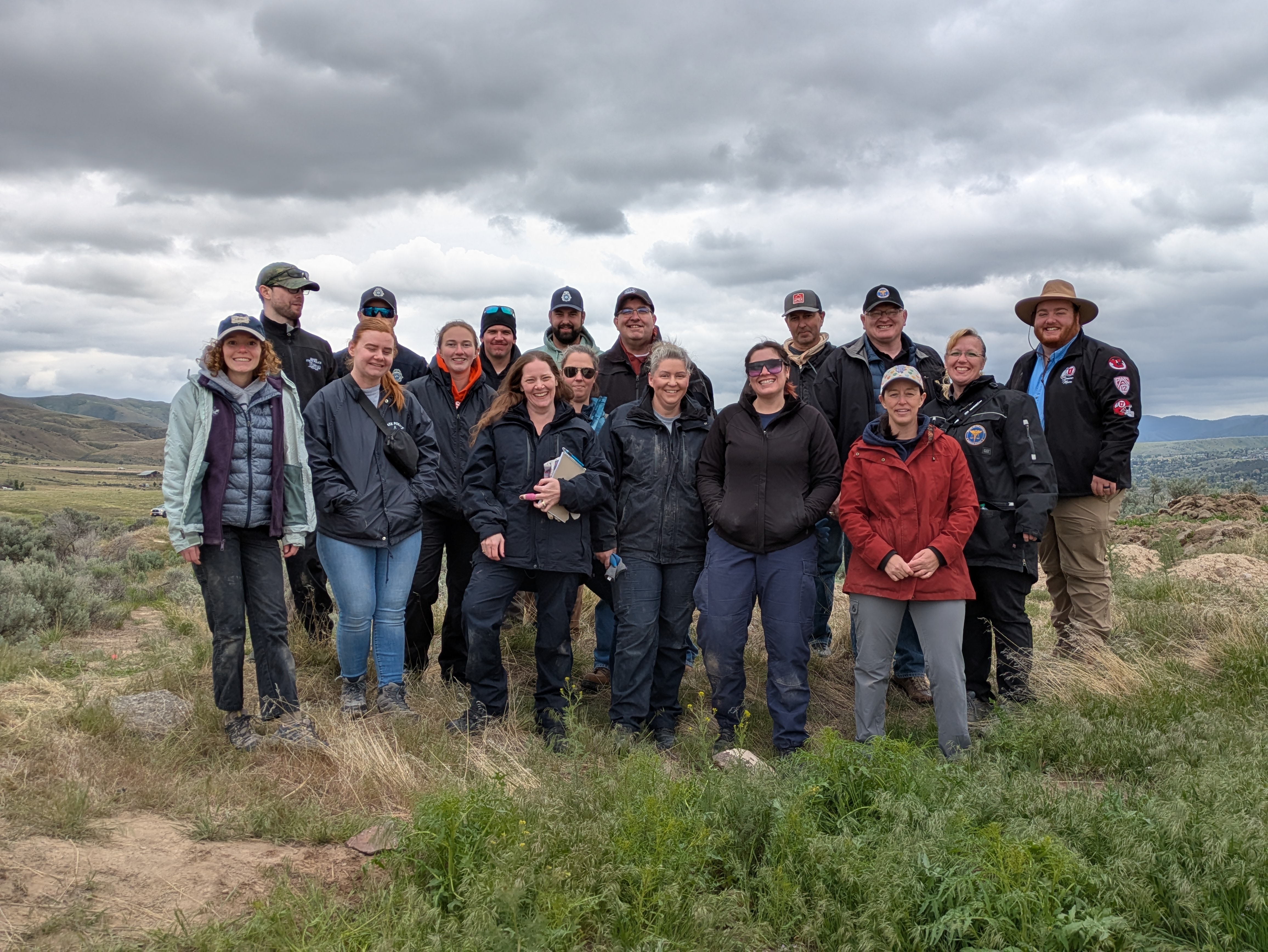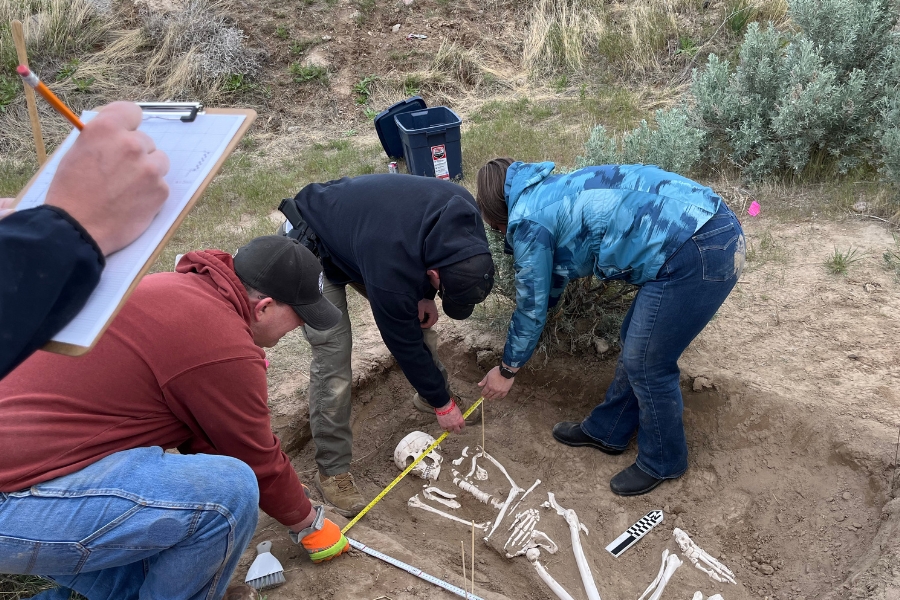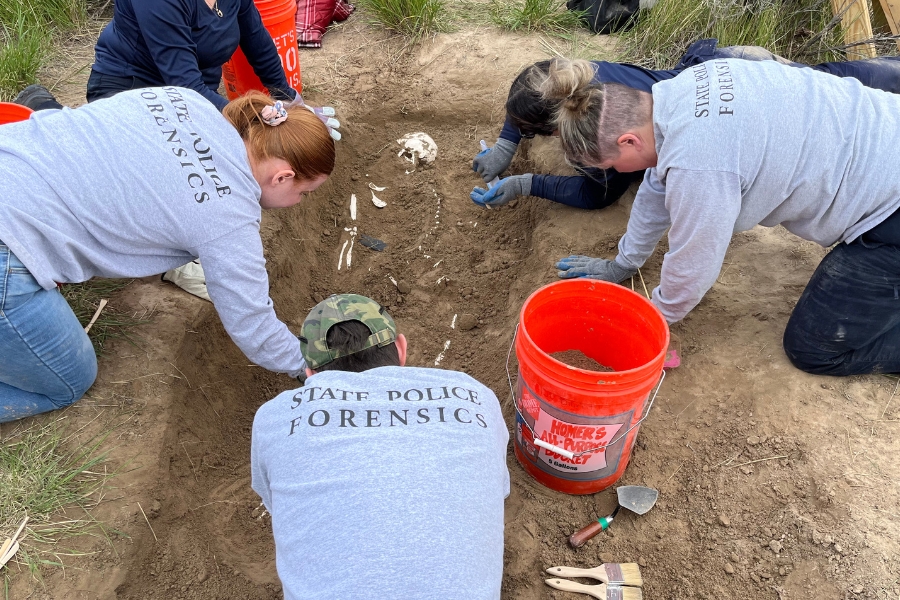Digging for Clues: Law Enforcement and Students Gain Hands-On Forensic Training in Pocatello

Participants from across Southeast Idaho—including coroners, forensic lab scientists, crime scene investigators, and students—gathered for a hands-on forensic excavation training led by ISU students and faculty.
Elisabeth Curtis
May 29, 2025
Students, faculty, and law enforcement professionals came together in Pocatello for a hands-on forensic excavation training led by ISU’s Department of Anthropology and Languages, simulating real-world crime scene recovery.
Against the scenic backdrop of rolling hills and the Stephens Performing Arts Center, three burial sites are being excavated by area law enforcement participants ranging from coroners to forensics lab scientists. The graves were dug about a month ago, which means they were fresh and relatively easy to find. Thankfully, they do not contain actual human remains. Though the bones uncovered are simulated, the techniques and methods are very real.
Participants from across Southeast Idaho including coroners, crime scene investigators, forensic lab scientists, and students gathered to practice the art and science of surveying, excavating, and recovering buried remains. The training, led by Idaho State University’s Department of Anthropology and Languages faculty member, Dr. Kirsten Green Mink, offered participants the rare chance to gain hands-on experience in forensic excavations.
“This is a mock excavation. We did classroom training yesterday on survey, search, and recovery methods,” explained Rachel Sutherland, a master’s student in Anthropology at ISU. “Today is practical application.”
She takes a moment to give instruction to the group of forensic scientists from Idaho State Police Forensic Services Pocatello and Meridian laboratories, who are on their bellies digging in the dirt around a synthetic human skeleton: “Usually corpses don’t spring up, but since the fingers are articulated, they’re moving,” she explains.
In groups spread across the training site, participants surveyed the area and flagged potential burial indicators before carefully excavating each site. The process is designed to mimic real-world forensic recovery scenarios.
ISU alumna Juliana Churba-Pyzer, who recently earned her master’s in sociology and criminology and is currently pursuing certification in forensic science and medical anthropology, was both assisting and learning. “There are definite rules and expectations for how to approach survey and recovery, but every anthropologist has their own methods or quirky tips and tricks,” she said. “It’s cool to observe how each group approaches the burial. This whole process is way more complicated than TV shows make it seem. It’s a lot of hard work.”
For professionals like Tara Martinez from the Idaho State Police Forensic Services Meridian laboratory, the training felt strikingly authentic. “This is exactly the way it was when I had to dig up a real site,” Martinez said. Reflecting on the techniques being used, she added, “This is accurate. It’s great training.”
Nearby, Spencer Moore, a graduate student in Anthropology, led a group through the mapping stage. “We’ve excavated until we found the remains, cleared the dirt, and now we’re mapping and transferring the burial site to graph paper,” he said. His group included participants from the Pocatello and Chubbuck Police Departments and the Bingham County Coroner’s Office.
A third group, guided by anthropology Ph.D. student Miles Rhoads, included members of the Bonneville and Bingham County Coroner’s Offices, Chubbuck Police, and the State Police SAKI Cold Case Team.
“In Bonneville County, we deal with a wide range of environments all the way to the border of Wyoming,” said Bonneville County Coroner Shantee Sanchez. “We’ve had experiences in the past with bones being found, and being able to identify whether they are human or non-human is critical. This kind of training helps us do that properly.”
The training also provided important crossover experiences for early-career professionals like Kaylee Kaminski, an evidence technician with the Chubbuck Police Department who got her degree in Anthropology from ISU last year and did an internship with the Chubbuck Police for her criminology AA. Kaminski says that having people across agencies that are familiar with this process is helpful in the long-run.
For Daren Boyd, a member of the Idaho State Police SAKI Cold Case Team, this class is his first training of this kind, and something that other members of his team have participated in. “With the cold case team, we work on missing persons and unidentified human remains,” he says. “I’ve been out on five cases already this year. This is a real-world application of something I already do.”
“You can never have too much training,” Kaminski says. “You can be under-qualified but I don’t think you can be overqualified for this.”




